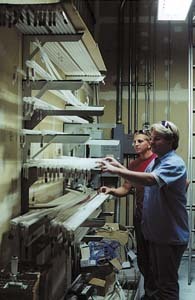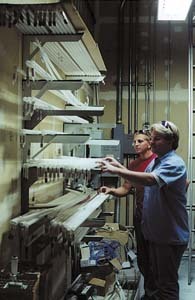LEDs + Lighting
The Time Domain
New lighting opportunities for sign companies
Published
18 years agoon

Several years ago, the owner of Modern Display Service, a large decorating firm in Salt Lake City, wanted a neon sculpture depicting a water fountain. His designers envisioned tiered, static blue tubes. The budget for the display, which would operate on stage for 10 minutes during a NuSkin convention program, was $10,000.
When the design director visited our plant, he picked three blue colors, plus white, from among a large display of glowing neon samples. The design and pattern were approved, but something was missing, because a real fountain has action and draws attention to its self.
Thirty-two years ago, at Scoreboard Animations, I worked alongside decorator William Vriens at Salt Lake City’s Salt Palace, engineering and marketing animated displays and scoring systems. During this stint, I learned that animation adds the time domain to communication.
As such, for the fountain project, I took a YESCO brand flasher, wired four neon transformers’ primaries and programmed the sequencer. Using the sequencer, I could start the first tier with the darkest blue color and ascend to the lighter blue, the lightest blue and, finally, to white. Once at the top, the fountain would collapse in sequence and build again.
When I discovered the neon exhibition would include an on-stage band and indoor fireworks, I built a small circuit to acoustically couple the fountain’s sequence speed with the music’s beat.
As a former sign sales manager, I subscribe to the adage, "If it doesn’t have a heart beat, it isn’t selling!" I challenge sign designers to add this time-domain dimension to their blueline callouts and program sequences for sales presentations. $image1
AdvertisementColor FX/Creator
Earlier this year, Multi Neon Ltd., a Lowel-Light affiliate (Brooklyn, NY), and MAF Technologies Corp. received a U.S. patent covering much of the basic technology used for the MultiNeon™ Color/FX Creator. Developed with theatrical neon specialist Kenny Greenberg, the invention embodies a plan to offer off-the-shelf products that let neon shops create, control and produce various special effects with color-changing neon.
The Color/FX Creator is a DMX- based (communication protocol over wires), full-range, three-channel neon dimmer, color blender and sequencing system that produces up to 16.8 million colors. It provides soft fades, flashing and other functions in conjunction with, or independent of, the color creation function. The system features MultiNeon’s self-addressing system, which eliminates the need for setting switches for each operation module.
Years ago, I simulated the actions of scintillating lights on an electronic message center controller and stored them for preview to produce the customer’s choice with hardware and software. Now, using an intelligent interface device called the PCDesigner I, the design department can load the software program on a laptop, which eliminates the need for access to a DMX board, neon tubing and transformers. Once the sequence is approved, the user simply uploads the PCDesigner device, instead of a DMX board, to control the installation. $image2
Changing colors
ColorChanger employs technology patented by Multi Neon, with DMX control, to change the color of neon within a single tube.
AdvertisementUsing standard neon tubes filled with a combination of neon and mercury, the electronic control/power unit energizes either, or both, of these gases to create a range of colors. Each phosphor has a unique color palette, one end determined by the combination of neon gas and the phosphor, the other end by the mercury vapor and the phosphor. The ColorChanger mixes the two end-points to achieve a maximum of 10 different color blends.
Certain preparations must be made before using the control unit:
Tubing and electrodes must be clean.
Tubes should be processed to higher than normal temperatures (275°C, minimum).
Electrodes must be completely converted.
Neon fill pressure must be 40 Torr (a unit of pressure that is equal to approximately 1.316 x 10-3 atmosphere or 1,333 pascals).
Tubes must be aged completely to a red color before introducing mercury.
Torr, micron and temperature gauges must be used.
Cold cathode is new?
At United States Sign Council’s Sign World USA, I visited exhibitors and asked to see what products had never before been displayed. I also asked what novel items they would show at International Sign Association’s Sign Expo 2001. From behind exhibit fixture cupboards came new power supplies for 120, 150 and 250mA cold-cathode lighting systems. This was new? Henry Brown, president of Transco (West Columbia, SC), said they have been supplying 250mA cold cathode transformers since 1979.
Europeans have been using cold cathode for decades. Marcus says that in Europe (Germany, Holland, England and partially in Italy), cold cathode is the main light source for backlighting big channel letters and an increasing number of acrylic signs. Its main advantage over standard fluorescents is its extended lifetime, which reduces service costs, especially in locations where accessibility poses a problem (for example, when you need a helicopter to change tubes).
In 1970, while employed by Federal Sign, I watched a glass technician fashion large xenon, high-voltage lamps for new airplanes to very tight specifications. Back in those days, such specialty lamps cost more than $100. Every new airplane received a complete set, because, it was explained to me, airplane manufacturing was highly regulated. I knew then there was big money in larger-diameter gas lighting.
In March of this year, I visited the Young Electric Sign Co.’s (YESCO) Las Vegas Div. manufacturing facilities and spoke with John Williams, a lighting designer and YESCO’s vice president and division manager. YESCO had just added a home-built (but very effective) oven for 25mm tube processing in its neon shop to facilitate cold-cathode lighting.
AdvertisementJohn said, "Our primary usage for the oven is repair work, and the only full project that we have done was some cove lighting in a small library. With the new code-compliance complexities of using neon for cove and valance lighting, we feel there will be a resurgence of the use of cold-cathode because of lower voltages and longer transformer and ballast secondary lead-length requirements."
Gary Hendricks, YESCO’s director of service, says the company has maintained the cold cathode 4500 warm white lighting at McCarran International Airport since 1986. The current contract includes 7,093 lineal ft. in 8-ft. lengths, mostly straight pieces and radius rings on columns. He said: "My experience, when units were purchased back East, was a 40% shipping breakage factor. The success starts with ‘German ends’ (electrode splice). The first units were very thin and broke easily. Make sure there is no powder in the splice."
I asked if any additional vehicle or personnel changes were required.
Gary replied, "We use normal glass racks on our trucks. It’s a little trickier to handle. Much of YESCO’s success is a result of two of our technicians, John Robbins and Eric Elazondo. Both started their career processing neon at an early age; John began when he was 14. Because the units contain mercury, there is no reprocessing. All units are new. Every two to three months, about 40 new tubes are processed."
LEDs as a lighting source
I counted 24 LED equipment vendors at the ISA International Sign Expo 1999 in Las Vegas. In Orlando, FL, in 2000, this number increased to 35 (about 12 didn’t return, so 23 were new), and this number increased to more than 40 vendors in Las Vegas in 2001. I counted 22 different vendors listed in various LED topics in the "ISA Sign Expo 2001 Guide." I found only two electroluminiscence (one listed) and one liquid-crystal (none listed) contacts.
Even vendors like Hi*Tech Electronic Displays (Clearwater, FL) were selling message centers, large-scale video and LED letter-installation kits in the same booth.
Light distribution
For those who have tackled the problem of evenly distributing light across a display face, 3M (St. Paul, MN) has a new light-management product called Light Transport and Extraction Film. Through a series of white dots to scatter light, top and bottom T-5 fluorescent lamps were transmitting edge-lit light evenly across a 21/2-in.-thin, double-sided cabinet. I have built hundreds of thousands of dollars of tri-sided signage for sports venues, but I have always had a problem front illuminating a tri-sided product incorporated in a scoreboard. There seems to always be a dark band across the middle, even with light diffusing and directing lenses.
At the March ISA Sign Expo, I borrowed Warren L. Langstraat, 3M’s business director, who took with him a sheet of the company’s new light-enhancement film, and visited Action Graphix’s (Jonesboro, AR) booth. We put three strips of the material inside a clear extruded triangular tube. With light directed towards the end, the triangular tube lit up uniformly, like a Star Wars’ light saber. What was designed to be a 2 x 3-ft., double-faced display became a 4 x 12-ft. triple-faced display. Ralph "Chip" Paonessa III, president of Hi*Tech Electronic Displays), lit the triangular tube with LEDs.
Also at the tradeshow, 3M presented a computer program that graphed the light distribution of cabinet lights. I asked if the program could suggest the ideal position of the lamps to get the best distribution of light across the graphic. "Not yet," was the answer from David J. Achten, 3M’s technical service manager.
In August, ST will explore the use of neon, cold cathode and LEDs in channel letters. ST will show some side-by-side photo comparisons and publish data from shops that have tested, baked, frozen or installed LEDs from Laughlin, NV, to Fairbanks, AK.
SPONSORED VIDEO
Introducing the Sign Industry Podcast
The Sign Industry Podcast is a platform for every sign person out there — from the old-timers who bent neon and hand-lettered boats to those venturing into new technologies — we want to get their stories out for everyone to hear. Come join us and listen to stories, learn tricks or techniques, and get insights of what’s to come. We are the world’s second oldest profession. The folks who started the world’s oldest profession needed a sign.
You may like
Advertisement
Subscribe

Magazine
Get the most important news
and business ideas from Signsofthetimes Magazine.
Advertisement
Most Popular
-

 Tip Sheet3 days ago
Tip Sheet3 days agoAlways Brand Yourself and Wear Fewer Hats — Two of April’s Sign Tips
-

 Business Management1 week ago
Business Management1 week agoWhen Should Sign Companies Hire Salespeople or Fire Customers?
-

 Women in Signs2 weeks ago
Women in Signs2 weeks ago2024 Women in Signs Award Winners Excel in Diverse Roles
-

 Real Deal4 days ago
Real Deal4 days agoA Woman Sign Company Owner Confronts a Sexist Wholesaler
-

 Editor's Note1 week ago
Editor's Note1 week agoWhy We Still Need the Women in Signs Award
-

 Maggie Harlow2 weeks ago
Maggie Harlow2 weeks agoThe Surprising Value Complaints Bring to Your Sign Company
-

 Line Time2 weeks ago
Line Time2 weeks agoOne Less Thing to Do for Sign Customers
-

 Product Buying + Technology1 week ago
Product Buying + Technology1 week agoADA Signs and More Uses for Engraving Machines












